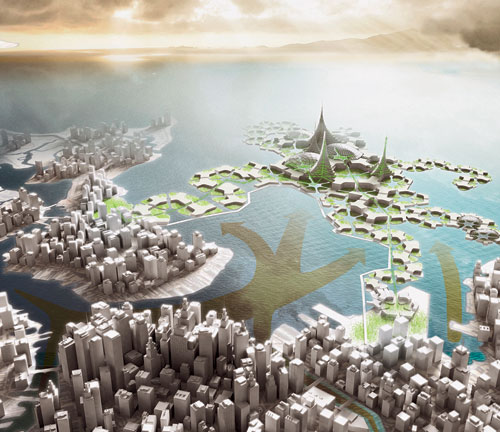Bracing for Climate Change
The report divides the country into eight geographical regions and lists potential impacts for each with short-term (2040), midterm (2070), and long-term (2100) scenarios. Included in the projections for the Southwest region, for example, are more severe rainstorms, flooding, deeper droughts, and a higher incidence of wildfires.
The study presents a series of adaptation strategies and assigns priorities for each region of the country. Many standard green practices, such as sunshades to reduce heat gain and beefed-up insulation, are “no regrets” steps that benefit the thermal properties of a building. Resilient strategies increase a structure's ability to withstand extreme events. “These need to be evaluated on a case-by-case basis, like scour-proofing foundations in flood-prone areas, for example, or using fire-resistant construction in places prone to wildfires,” says Rajkovich. The report points out that there is currently a knowledge gap in the ability to fine-tune climate data. Both San Antonio and Bismarck, North Dakota, are in the Great Plains region but can have very different climatic conditions. The report emphasizes that an essential future refinement will be the “downsizing” of the climate data to more specific locations.
The Roles Of Government And Insurance
The global insurance giant Munich Re released a report in October stating that the incidence of weather-related disasters increased fivefold in North America between 1980 and 2011, the highest increase in the world. The report focuses on human-induced climate change and calls for action to mitigate the problem while adapting and protecting assets. In high-risk states like Florida, the insurance industry has been instrumental in pushing for building codes to require stronger measures to protect against storm-related damage. And some individual insurers are pulling back from coastal areas altogether. Recent images of stick-built houses strewn along the New Jersey coast highlight the importance of codes and zoning in life safety and protecting assets. The Dutch are using “managed retreat” in some areas—relocating assets and residents to allow the water back in.
Most flood insurance in the U.S. comes from the public sector. The National Flood Insurance Program is administered by FEMA and often pushes local codes and ordinances to require flood-resistant measures such as the one in Brattleboro, Vermont (see sidebar). FEMA encourages builders to consider materials and assemblies that are wet-tolerant and that dry readily, such as masonry and noncavity wall assemblies. It discourages placing any living or work areas in the floodplain, preferring that those zones be reserved for utilitarian purposes such as garages or storage. One advantage of wet floodproofing is that it can reduce structural damage due to hydrostatic pressure. All spaces should have openings or drains (such as crawlspace vents) sufficient to allow water to flow freely in and out of the structure to equalize the pressure. The country is likely to see more political debate over the policies and costs of adapting to climate change. But it's interesting to note that the one government agency that's facing the issue head-on is the Department of Defense. Besides considering threats to national security, DOD is currently evaluating its facilities for rapid adaptation to climate change.
 |
Delta locations like Rotterdam could take advantage of their position by building floating cities that would recycle nutrients for agriculture and aquaculture. Illustration by Deltasync |
Sustainability Is Resilience
In a recent op-ed in the New York Times, “Forget Sustainability. It's About Resilience,” Andrew Zolli points to the many LEED-rated buildings in New York City that sustained damage during Sandy as proof that the green-building movement has failed to focus on resilience. It's true that we need to ramp up adaptation, but to abandon the fight against the causes of climate change is to ignore the disease while treating the symptoms. A broader view might be more productive: “It's not an either/or situation,” says David Waggonner. “We need to set priorities for integrated solutions at every level.”








